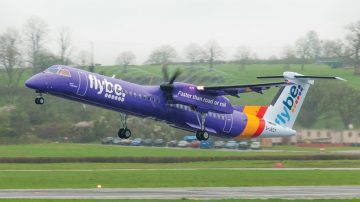
African aviation is ripe for expansion – now policymakers need to make it happen, writes David Whitehouse
When Alex Dichter, now a senior partner at McKinsey & Company in London, tried to go to war-torn Goma in the eastern Democratic Republic of Congo in the late 1990s to do voluntary work, the first problem was getting in. There was no functioning government and no official flights. The only solution at Kigali airport in neighbouring Rwanda was for Dichter to go over to the cargo area with a couple of bottles of vodka in his rucksack and use it to “hitch a ride” with one of the mercenary Russian and Ukrainian aircraft that were ferrying arms into the DRC.
There are usually more conventional ways to get a flight within Africa. But it can mean flying out to Europe and then back into Africa again. Why, for example, is it impossible to fly direct between Kinshasa in the DRC and Nigeria’s commercial capital, Lagos? These are already huge cities and will become megalopolises in the future.
African aviation policymakers understand the potential of greater competition and increased direct services, but have multiple and conflicting objectives and constraints, Dichter notes. They may want to increase aviation services, and also need to protect domestic aviation jobs, “but they can’t have both. The desire to protect is politically powerful.” Many countries suspect that if exposed to real competition, their own national carrier might struggle to survive.
To state the obvious, Africa is a growth market for aviation. The International Air Transport Association (IATA) forecasts 5.9 per cent year-on-year growth in African aviation over the next 20 years, with passenger numbers expected to increase from 100 million to more than 300 million by 2026. That suggests the possibility of Africa becoming a less fragmented continent with greater air connectivity, opening up economic benefits across the board.
An IATA survey in 2014 suggested that if 12 key African countries opened their markets and increased connectivity, an extra 155,000 jobs and US$1.3 billion in annual GDP would be created in those countries.
Much remains to be done if that potential is to be realised. “Too many African governments view aviation as a luxury rather than a necessity,” argues Katherine Kaczynska, IATA’s corporate communications manager for the Middle East and Africa. “That perception needs to change. The value of aviation for governments is not in the tax receipts that can be squeezed from it. It is in the economic growth and job creation that aviation supports.”
Kaczynska points out that the global average profit per passenger is US$7.80. But airlines in Africa on average lose US$1.55 for every passenger carried. There are many reasons for the disparity. Jet fuel costs in Africa are 35 per cent higher than the rest of the world. User charges – paid by airlines and passengers for the use of aviation infrastructure – make up 11.4 per cent of airlines’ operating costs in Africa; four times that of North America.
Taxes and fees are among the highest in the world. In Niger, US$80 from each ticket is paid to the government in fees, taxes and charges. Cameroon recently added a US$37 development tax per passenger. The DRC charges every arriving passenger US$15 to promote tourism, while Ethiopia’s US$24 departure tax undermines the hub’s competitiveness.
A further challenge for airlines in Africa is the ability to reliably repatriate ticket revenues generated in other countries in line with international treaty obligations, Kaczynska says. Currently, ten African countries have blocked funds worth a total US$670 million. Blocking airline funds puts connectivity at risk, and invites broader economic problems. “Urgent dialogue is the first step, with creative and proactive mitigation plans following closely behind,” Kaczynska argues.

Colonial roots
Rapid economic growth is stoking demand for business travel in many sub-Saharan economies. But, according to BCD Travel’s 2019 forecast, supply is unable to respond fully, owing to regulation and high airport taxes, so regional business fares are set to increase. Many direct routes that business needs don’t yet exist and won’t any time soon.
As a result, non-African carriers cover 80 per cent of the African market. While there is an increase in African carriers such as Ethiopian Airlines, South African Airways, Kenya Airways, Air Cote d’Ivoire, Royal Air Maroc and Egyptair, they cannot fully compete with European or Middle Eastern airlines that have broader global long-haul coverage with which to subsidise African routes.
Intra-region visa restrictions are another major impediment. According to the Africa Visa Openness Index, Africans on average need visas to enter 55 per cent of states within the continent.
Anthony Chibo-Christopher, chief executive of Sun Business Strategies and Research in Nigeria, claims that he can fly to New York for about US$500 but it costs him US$1,200 to fly to Dakar, Senegal. There is a tendency, he says, to think of Africa as one. In fact, prior to colonialism, Africa was made up of a wide variety of kingdoms, most of which did not know much about each other.
The result, he says, was that trade was defined by the colonial relationship with Britain and France. African countries did not develop their own trading relationships. “Travel follows trade,” Chibo-Christopher says – Nigerians now want to go to London, and Ivorians to Paris.
Dichter at McKinsey says that the amount of trade, and therefore business travel, between Anglophone and Francophone Africa remains limited.
The problem that bedevils African air travel now, Chibo-Christopher says, is a lack of public and private investment. The result is that Kenya Airways and Ethiopian Airlines are criss-crossing Africa with few rivals. Competition is needed to bring prices down. Destination taxes are high, he adds, as high as at Heathrow, but without the infrastructure to match.
Governments need to cut taxes and regulation, Chibo-Christopher says. Demand for air travel in Africa is growing, he points out – there is, for example, a lot of demand to fly to Kigali because of its international status. But only state-controlled airlines are benefiting, he says; new airlines are needed. And yet it’s hard to start up as an airline, making deregulation essential. He points to Air Peace in Nigeria as an airline that provides a good service but faces political and regulatory pressures, and no government subsidies. “They’re not getting a fair deal,” he says.

Opening the skies
The launch last year of the Single African Air Transport Market (SAATM) initiative by the African Union to open up Africa’s skies and improve intra-African air connectivity is “cause for optimism”, argues IATA’s Kaczynska. “Every open air service arrangement around the world has boosted traffic, lifted economies and created jobs,” she says.
This dates from 1988, when some African countries agreed to liberalise the aviation sector, and was formalised in the 1999 Yamoussoukro Decision, in which 44 states agreed to start liberalising air transport, but it was not implemented until 2018.
Still, research from Deloitte published in May last year, Single African Air Transport Market: Is Africa Ready?, argues that low commitment from African Union member states is a likely result of the treaty’s lack of a proper implementation framework. Deloitte says that Nigeria has backtracked on the agreement after signing, complaining that Ethiopian Airlines makes 45 per cent of its income from Nigeria, yet has not employed Nigerians as air crew or ground technical staff.
According to Deloitte, a lack of a proper consumer protection mechanism will reduce the effectiveness of SAATM as passengers do not have a platform for seeking redress. All signatory member states will need to “adopt and enforce harmonised consumer protection regulations to give consumers across the continent a level playing field.” Only then will SAATM be able to achieve its objectives.
“Making it a reality requires governments to move promptly in creating the enabling regulatory framework and for the airlines currently sheltering behind their protection to become competitive,” Kaczynska says.

Potential for success
Deloitte points out that Africa is home to 16 per cent of the world’s population and yet only has a share of 2.2 per cent of global air passenger traffic. Can such a glaring disparity be sustained? “Africa has the necessary elements to become an aviation success story – a growing middle class, favourable demographics and a geography that necessitates travel by air,” Kaczynska says. “However, many of the region’s governments are not treating air carriers as partners that drive social and economic development.”
Dichter at McKinsey believes that the African business air travel market is “starting to mature” and that a quality short- to medium-haul airline can emerge, provided there develops a hub that can generate sufficient passenger scale.
There are signs of such an airline emerging – in December last year Green Africa Airways, a Lagos start-up, placed an order for up to 100 B737 Max 8 aircraft. The list price of US$11.7 billion is the largest order ever placed by an African aviation firm. The plan is to attack the Nigerian market and then expand into African routes.

Airlines in Africa
5 major players…
South African Airways
A Star Alliance member, South African Airways has been in operation since 1934 and flies to 57 destinations around the world. Its newest aircraft, the
A330-300, was placed on the London-Johannesburg route last year. flysaa.com
Ethiopian Airlines
Founded in 1945, this Star Alliance carrier flies to more than 119 international destinations. The airline opened a new terminal and own-brand hotel at its Addis Ababa hub in January. The B787-9 was introduced to its fleet in 2017. ethiopianairlines.com
Kenya Airways
From its Nairobi hub at Jomo Kenyatta International, Kenya Airways flies to 43 destinations in Africa and 14 outside the continent, including London Heathrow. A Skyteam member, its fleet includes the B787 Dreamliner. kenya-airways.com
Egyptair
Egyptair was established in 1932 and now flies to more than 75 global destinations. Operating from Cairo International airport, the Star Alliance carrier launched a twice-weekly service to Hong Kong in September last year. egyptair.com
Rwandair
Rwanda’s national airline flies out of Kigali International airport to 26 cities in Africa, the Middle East, Asia and Europe, including London Gatwick. Next month, it will launch direct services to Addis Ababa, and there’s talk of flights to New York and China in the future. rwandair.com

… and 5 to watch
Green Africa Airways
This low-cost Nigerian carrier based in Lagos has not yet begun commercial operations but it has big plans. The airline recently announced a commitment to 100 Boeing 737 MAX aircraft, with the goal of building a pan-African network. greenafrica.com
Kulula
Owned by Comair, this South African budget airline connects cities including Johannesburg, Cape Town and Durban within South Africa. It also serves Nairobi via a codeshare with Kenya Airways, and interlines on the domestic and regional network Comair operates for British Airways. kulula.com
Jambojet
A subsidiary of Kenya Airways, this low-cost carrier flies from Nairobi to six Kenyan and Ugandan destinations. Founded in 2013, it will add two Bombardier Dash 8 Q400 aircraft to its fleet later this year. jambojet.com
FlySafair
Based at Johannesburg OR Tambo International, FlySafair took its maiden flight in 2014. The low-cost airline flies to seven airports in South Africa, including Cape Town and Durban, using B737 aircraft. flysafair.com
Air Senegal
Senegal’s national airline flies to four African cities, including Banjul in the Gambia and Praia in Cape Verde, from its Dakar base. Not even a year old, it launched flights to Paris in February (see our feature on new airlines on page 62). flyairsenegal.com












